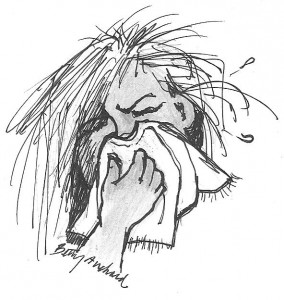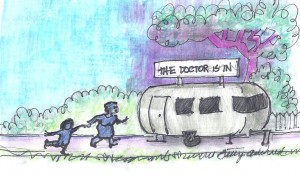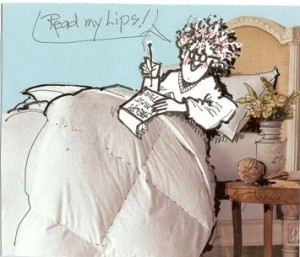 Any resident at The Home who had reached the age of eight had to take a turn doing nose rag duty. I had that job more than once. A big girl and two little girls were assigned to work together, and their task was to keep a large supply of clean cloth squares ready to be used by any kid with a snotty nose. We tore 12” squares from old, soft, worn out sheets and turned them into something new: handkerchiefs for kids with colds. The raggedy pieces were not hemmed, and loose threads hung from the edges. Some of the more creative kids pulled the threads away from each edge to make fluffy quarter-inch fringe. Mrs. Stone, the girls’ monitor, considered making fringe a useless activity. “Girls, get on with it,” she would say. “You’re taking too much time.” But fringe made the edges of the rags look nice and pulling the threads made the process a more satisfying activity, so we did it as often as we could get by with it.
Any resident at The Home who had reached the age of eight had to take a turn doing nose rag duty. I had that job more than once. A big girl and two little girls were assigned to work together, and their task was to keep a large supply of clean cloth squares ready to be used by any kid with a snotty nose. We tore 12” squares from old, soft, worn out sheets and turned them into something new: handkerchiefs for kids with colds. The raggedy pieces were not hemmed, and loose threads hung from the edges. Some of the more creative kids pulled the threads away from each edge to make fluffy quarter-inch fringe. Mrs. Stone, the girls’ monitor, considered making fringe a useless activity. “Girls, get on with it,” she would say. “You’re taking too much time.” But fringe made the edges of the rags look nice and pulling the threads made the process a more satisfying activity, so we did it as often as we could get by with it.
In the hall near the bathroom were two flour-bin type hampers that tilted out from the wall. Next to them was the dumb waiter that went clear to the basement. One hamper was labeled “clean” and the other “used.” The clean hamper was filled to the brim with freshly laundered, wrinkled squares that we could grab anytime we needed to blow. We balled a rag into a fist shape and carried it around that way. When we felt a sneeze coming on we unfolded the cloth ball quickly and searched for a fresh, dry place to blow into. We carried that lump of fabric around with us and blasted our noses into it until there were no dry spots left. Used squares were wadded into misshapen clumps before being tossed into the hamper labeled “used.” There, they dried into crispy shapes like kindergarten art projects.
Used nose rags were traps that collected germs and probably helped share our colds with every other kid who lived there. But it was unthinkable to throw them away. If we were assigned to nose rag duty, we pre-washed the crusty balls in the bathtub with Fels Naptha soap. After being rinsed and squeezed, the cloth squares were put into plastic pans and sent to the basement by the dumb waiter. There they were washed again in sudsy hot water in the Maytag, rinsed in bleach water, then pushed through the rubber rollers to squeeze out as much liquid as possible.
We hung them on the clothesline in the sunshine in small bundles caught at the corner with wooden pins that looked like little men with no faces or arms. In summer, the crude hankies dried quickly in the hot sun. In winter, they freeze-dried on the same clothesline. Mrs. Stone said that freezing the white cloths made them whiter, and I believed her because she was a grown up. When they had dried, we tossed them into the pull-out bin labeled “clean” where they were ready to be used again.
In addition to the nose rags, we shared or recycled just about everything at The Home for the Friendless: toys, combs, the bathtub, drinking glasses, and germs. Of course, we exchanged germs with family members when living at home with our parents. But at The Home for the Friendless, there were more people to share them with.
We didn’t think much about germs at the time. But we did understand the importance of the work we had to do at the home because the adults told us we were learning to be responsible. Any messes we made we had to clean up ourselves. Nose rags were just another mess, but it was one we avoided as often as possible. That’s why the threat of extra nose rag duty was an effective deterrent to bad behavior at The Home for the Friendless.
____________________________________________________________________________________________
excerpt pg 77 from The Home for the Friendless, by Betty Auchard–illustration for this blog by Betty Auchard
www.bettyauchard.com
During the winter of 1937, Mama took Bobby, Patty, and me to live at the Home for the Friendless. She said, “This is a nice place. You’ll like it here, and I’ll visit you every week.”
Whenever our parents broke up, we three kids stayed at Grandmother Peal’s house. But this sudden change made me so tense that my scalp hurt. The Home for the Friendless was a dark three-story building where a lot of other kids lived, too. I hoped they were as nice as our cousins.
The lady in charge looked grumpy, but she really wasn’t. She said, “You can call me Mrs. Kurl, even though my hair is straight as a ruler.” I knew she was trying to drag a smile out of us, but it didn’t work on me. She said, would you like a tour of our facility?”
Facility? That sounded like a jail. I just wanted to go home, but Mama agreed to see every room, and we followed.
The Home for the Friendless was musty like the basement in an old building. There were no curtains, so our voices echoed in the hallways. When I saw where each of us would stay, a hot, sweaty feeling broke out on my chest. We three kids would not be together. When Mama kissed us goodbye, she said, “You be brave now because this is a very nice place.” I squeezed back my tears Did this mean we were orphans?
Bobby and I saw each other at mealtimes, but I slept in the girls’ dorm, he slept in the boys’ dorm, and my two-year-old sister slept in the nursery. I never knew what she had for breakfast each day. When the children in the nursery played outside, they were right next to the girls’ side of the playground.
I waved to Bobby and Patty whenever I could. I wanted to show them the tooth I had just lost and the bloody hole it had left in my gum, but I couldn’t. We could only see each other on weekends when Mama, Damsy, or Grandmother Peal came to visit. By the time we got together, the empty hole in my gum was no longer repulsive enough to show anyone.
Bobby was happy at the Home and played with a red kiddy car that he pedaled with his feet. He yelled across the low peony hedge, “Sister, I like it here!” I wanted to squeeze him with a tight hug, but we couldn’t leave our assigned areas. My little brother didn’t seem to need me anymore and that’s when I sucked my thumb. It kept me from crying.
I saw Patty a lot because her playground was close by. I wasn’t allowed to play with her either but I spied on her as much as I could by hiding behind a tree trunk. I loved watching her up close because she was so cute with her rosy cheeks and bright red hair. If the nursery monitor caught me she would say, “Stay in your own area.”
One day when the air was so cold I could hardly talk, I noticed my sister crying. The monitor was busy with other kids and hadn’t noticed Patty’s bawling. My heart ached. She looked pitiful and cold. and her cheeks were as red as her hair. I could see her nose running and couldn’t bear her misery, so I marched straight to the off-limits playground to hug her and wipe her snotty nose with my mittens. Then I started closing her jacket. Patty tilted her head down to watch what I was doing, and I caught her bottom lip in the zipper. She screamed. I pulled the zipper back to set her lip free, and blood flowed down her chin.
When the monitor saw blood all over Patty’s mouth, her eyes bulged as she rushed toward us and screamed, “What have you done to this little girl?” She thrust her finger in the air and said, “Get back to your own area, and stay there. You are not uh-llowed on this playground!” She punctuated the words and spit flew everywhere.
I sneaked back to my private tree trunk and planned to kidnap Bobby and Patty. We would run away to Grandmother Peal’s house. I was sure I could find it. She would not be expecting us, but I could say, “Hello, Grandmother. How ya been? Would ya like some company?”
I knew I couldn’t really run away, so I sucked my thumb instead and counted the days until the weekend.
Excerpt from the award-winning memoir, The Home for the Friendless by Betty Auchard — available on Amazon as an eBook and audio book.
This is a letter I received from a fan, Darryl Trapp, who read my newest book: The Home for the Friendless
As I’ve gotten older, I’ve discovered that I simply cannot eat and drink the same things that I did when I was in my twenties. First to go were Vodka Gimlets (lime juice = acid indigestion). Next it was eggs (I developed an allergy.) After last night, I’m crossing red pepper hummus off the list.
When I was a kid, my mother was convinced that comic books, scary movies, and Dr. Seuss would give me nightmares. The only time I could get a fix of “Green Eggs And Ham” was if I snuck off to the children’s table at the doctor’s waiting room and pretended to be reading “Highlights” magazine. I can honestly say, though, as far as I can recall, none of those taboo objects of my childhood actually caused my nightmares, at least not directly. I read comic books at my best friend’s house, saw both “Psycho” and “The Birds” as a young child (thanks to my older siblings), and feasted on Dr. Seuss books at the doctor’s office. I had nightmares, but they usually had to do with flying and suddenly dropping out of the sky.
I’ve come to the conclusion that certain foods bring on these nightmares. Like Ebeneezer Scrooge, that “bit of undigested potato, that dab of gravy” can wreak havoc on a night’s sleep faster that you can say “double dip sundae.” Last night I had a snack of pita chips and red pepper hummus before going to bed. I paid dearly for it. I dreamed myself into Betty Auchard’s book, The Home for the Friendless – but I was an eight year old Betty whose mother was taking her for an operation. 
I (as Betty) had developed a weird, mysterious growth, underneath the surface of the skin on my face, and it needed to be removed…not my face, but the growth. Without batting an eye, Betty’s mother, Waneta, escorted me to the local doctor, who evidently didn’t feel the need to operate within the confines of a hospital, but instead of an operating room, he used a hybridized Airstream trailer that was parked in his driveway. The sign on the roof said, THE DOCTOR IS IN. Very convenient for the emergency removal of almost anything.
The operation was a success, but to my horror, I discovered that the “growth” was a whole other face, complete with nose, chin, brow and lips, which the doctor had somehow removed all in one piece. It looked a little like the mask used in The Phantom of the Opera; white and waxy. Disoriented from the anesthesia, and terrified by this bizarre turn of events, I slipped away while the doctor was otherwise occupied, wanting only to be home with my mother. Keep in mind that I was a homeless 8-year-old Betty in this dream.
Moving from backyard to alleyways, I traveled from suburb to downtown. Nothing looked familiar. This was Cedar Rapids, Iowa of the 1940’s, complete with streetcars and congested with pedestrian traffic, but with a very different topography. The streets had changed and suddenly bisected at acute angles. The real Cedar Rapids is laid out in a square grid. In the dream, buildings shot up to impossible heights, bypassing the modern skyscrapers that exist today. Hills popped up where none had existed before. Everything had taken on an odd, dusty coloration.
I wandered into a department store looking for help, and suddenly even the laws of physics had deserted me. Without warning I found myself climbing up the banister of a set of stairs sideways as if it were a ladder. A trapdoor loomed in the floor – which was actually the ceiling of this topsy-turvy world. I could see two saleswomen, far below or was it above? I tried calling out to them for help, but my voice dwindled away, like a whisper on the wind. I was lost and alone, hurting and sad, and all my eight-year-old self wanted was to find my way back home. I was lost and friendless.
I woke up shaken and sweaty. From here on, I’m sticking to warm milk for a bed time snack. And just to be safe, I’m avoiding Dr. Seuss.
By Darryl Trapp, a grown up man
As many of you know, I gave up visual arts for writing over 12 years ago to write books; the most recent being The Home for the Friendless. However, I had a profound art lesson experience from nature this year. I had neglected to rake up the endless array of leaves in my back yard before the rains came. After many weeks of lying around on grass and ground, the result was shallow mounds of moist, moldy compost everywhere: the lawn, concrete, and wooden deck. When I finally took time to scrape it all up, fat little sow bugs scattered to reveal an art show of flawless leaf prints. Mother Nature was trying some of her innovative techniques. Images were layered, wrinkled, crinkled and flat in stunning shades of reddish-black to grayish-mauve. I showed my children when they came to visit and we all agreed; “This ”found art” must be photographed.” But we never got around to it before the lawn mowing man arrived to groom and clean up the back yard.
Clean Up is the ugly term here. Mowing Man left and the back yard was as tidy as I’ve ever seen it when it dawned on me that he had hosed and scrubbed away nature’s art project. You might think this a fish tale like the leaf prints that got away. It’s not a tall tale, but it does remind me that beneath each unsightly surface, some beauty doth remain. http://www.natureprintingsociety.info/ 
Here is another way to create prints made with leaves that will NOT get away.
1. Find a sturdy leaf from a tree and dip it into water with detergent added. Blot dry.
2. Paint the vein side with water colors or any paint that dries fast.
3. Place painted side onto clean paper.
4. Drop a Kleenex on the leaf and press, being careful not to budge the leaf one bit.
5. Remove Kleenex, then the leaf and hope for a good print. Problems occur when using too much water or when moving the leaf while printing. Just practice this part.
6. “Leaf” the print alone or add things to it such as arms, legs, hats, or high heels.
7. Admire and show it to friends.
____________________________________________________________________________
Try this out; it’s fun. What caption would you suggest for this print?
My sister, Patty, was five years younger than I. I say “was” because Patty died in March 2010. She never got to see the stories in The Home for the Friendless published along with the family photographs and the glossary called Betty’s History Lessons. I had printed all the pieces that included her and had them bound so she could read them while she was still well enough to do so. Without the help of my brother, Bob, and my sister, Patty, there would be no book.
I had placed a long distance call to my sister in June, 2007, so we could discuss the details of her favorite story. It was about a trick that Bobby and I had played on her, but not to be mean; to make her feel better. I’m not sure she ever believed that, but it was the truth. On the day of the phone conversation, Patty was trying to give me the real details of this event that had made her cry her eyes out when she was only ten. While telling the story from her point of view, she coughed so frequently that she couldn’t finish a sentence. I urged to her to stop and we’d continue another time, but she wouldn’t give up. Finally, I insisted that she get her husband on the phone and she did. He said that they had an appointment with the doctor to see why she couldn’t get over that stubborn cough.
The stubborn cough turned out to be throat cancer and her larynx had to be removed.
For the next three years Patty wrote notes as fast as she used to talk. Her husband bought 9×6 lined yellow tablets by the package. When she was really excited, she tried to mouth the words as she gestured wildly, fingers pointing and hands flailing the air. It was truly funny and it made us all laugh hard including Patty though we couldn’t hear her. We were a close family and one of our own was in bad shape, so we got used to dark humor.
When Patty was in the hospital she had to learn to communicate with note-writing. She once wrote this note to me: “I should learn sign language because no matter WHAT I need help with, I have to write it down.” I wrote back that everyone else would need to learn it, too, but she was laughing silently again, and I didn’t get the joke. So she wrote me this note: “Stop writing. YOU CAN TALK.” So I created a card just for her. She loved it and so did the nurses. Thank goodness I made a copy because the nurses liked it so much that she gave them the original. The card is here.
You might notice that I drew the cartoon of my sister then cut it out and pasted it on top of a picture from a catalogue for down comforters. I also added a few lines on top of parts of the magazine image to tie the whole thing together. You can’t read the note on her tablet, but she could. Since my sis couldn’t talk after turning on her call light for a nurse, she got used to writing, “I have to pee.”
_________________________________________________________
In memory of Patricia Ann Reffel 1935 – 2010
During the Great Depression and long afterwards, many poor people didn’t have indoor plumbing. My family was in that category, so naturally, we heard many humorous horror stories about outdoor toilets. My husband remembered very clearly that during the winter time in Kansas when he was just a little kid, he fell through the large hole and managed to crawl out an opening in the back. Lucky for him that everything below was frozen solid.
In my book, The Home for the Friendless on page 110, is another outrageous story of an outhouse adventure. My grandmother was babysitting all of my cousins on the farm after their mom was resting up from the birth of her 7th child. While I was there, the family dog, Spike, fell through the outhouse hole onto the foul waste below. It was summertime and nothing was frozen. What to do? Grandmother lowered my nine-year cousin, Hubert (what a little hero he was), headfirst into the hole while all the rest of the cousins held onto her skirt and to each other. Hubert grabbed Spike and both he and the dog were pulled back out into fresh air. But Spike staggered to his feet and shook his coat furiously, sending icky stuff flying every where. A few of the kids helped Grandmother to grab Spike and hold onto him real tight while the rest of the kids hosed him clean. It meant that every kid who got splattered had to strip naked and get hosed off, too, and their clothes tossed into the rain barrel. It was an awesome sight: kids running around naked squirting each other with the hose and Grandmother standing there with shoulders sagging, waiting her turn.
I have no doubt that reading this has brought an outhouse story of your own to mind. So, let’s hear it.
During the winter of 1937, with no warning, my mother dropped off my brother, sister, and me at the Home for the Friendless in Cedar Rapids, Iowa. She said, “This is a nice place. You’ll like it here, and I’ll visit you every week.” We were met by Mrs. Kurl, who looked grim, but turned out to be a nice lady. She gave us a tour, and the place was so big our voices echoed in the halls.
At that time, during The Great Depression, childrens’ homes were full of kids whose parents could not afford to take care of them properly. Although I knew that, I still felt abandoned. Since I didn’t want my younger brother and sister to be scared, I wore my happy face, but when I found out we would be separated into three different dorms, I couldn’t hide my sadness.
The foster parent program today may avoid some of the issues that arise from housing children in institutions, but foster kids still have a rough entry into life at 18 when they roll out of the program.
What is your experience with children who feel abandoned? Are you a foster parent or a counselor? Did you grow up with both parents and still feel alone sometimes?














